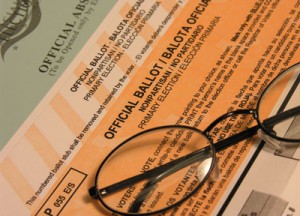Gregoire inks ballot design improvements
 Governor Gregoire has approved legislation aimed at improving ballot design in Washington, making it less likely a voter will miss important issues.
Governor Gregoire has approved legislation aimed at improving ballot design in Washington, making it less likely a voter will miss important issues.
The measure, House Bill 2496, will require counties to clear up visual clutter on their ballots, and make sure that the voter-instruction section is clearly separated from the actual beginning of the voting itself.
The bill, sponsored by Rep. Scott White of Seattle, grew out of apparent confusion by many King County voters last November, when about 7 percent of the voters, or over 40,000 people, failed to cast a vote for Tim Eyman’s anti-tax Initiative 1033 after voting on the “everything but marriage” Referendum 71. The initiative was at the bottom of a block of copy as the voter instructions, and the rest of the ballot started in a fresh new column of text.
Since the measure was rejected by a landslide statewide, the undervote didn’t affect the outcome, but state and local election officials resumed their ongoing efforts to improve ballot design. It has been a national topic of interest among election officials since the “butterfly” ballots in Florida and elsewhere greatly confused voters.
Secretary of State Sam Reed and Elections Director Nick Handy were among the backers of the legislation, which takes effect in June and authorizes the Secretary to establish statewide standards for ballot layout and design. Handy says:
“This legislation is a major step forward in ensuring that ballots are designed to be more voter friendly. We are working with Jenny Greeve from the nonprofit group Design for Democracy and our great County Auditors to improve ballot presentation. We all have the same goal of having ballots that are clear and readable and that assist the voter in moving down the ballot with ease. We want the civic act of voting to be enjoyable, and not perplexing in any way.”
Many improvements already are being made, and the statewide standards will be ready by next year. Handy also noted that starting last fall, the state Voters’ Pamphlet already is incorporating the new design and readability features.
Another elections-related bill passed by the Legislature is House Bill 1880, which removes the requirement that mail ballot return envelopes must have a secrecy flap to conceal the voter’s signature and telephone number. The governor has yet to take action on this proposal.
The Secretary’s main elections request bill, however, did not pass. Reed, the County Auditors, military and veterans’ spokesmen and others sought legislation to make it easier for military and overseas voters to cast their ballots by fax or email from remote locations. The House strongly approved the bill and it cleared Senate committee, only to die without a vote by the full Senate.